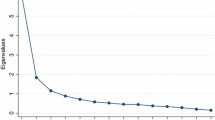Abstract
The paper deals with creation a model influence of interest of groups on public policy decision making. The results of the study showed that the use of Likert data is a very important element in research. In this case, it allowed us to understand who influences decision-making. It is worth noting that we obtained quite interesting results based on using the method of principal components and confirmatory factor analyses. The application of existing modeling tools helped us to determine the factor loads and assess the significance of the obtained models for choosing the best appropriate. Confirmatory Factory Analysis is very important approach in determining the influence of stakeholders on public policy decision-making. However, this approach has some limitations, forming data, it is necessary to form groups with an equal number of participants. There is some limitation usage descriptive statistics for discrete data. The authors point out that there is the strong covariance between latent factors Policy and Administrative. This investigation shown that Authorities, Political parties and Domestic business strong legislative influence on formation of state policy and approving of management decisions. On the other hand, Government analytical centers, non-governmental analytical centers, foreign donor organizations, Ukrainian donor organizations, ordinary citizens, participants of street actions executively influence on formation of state policy and approving of management decisions.
Access this chapter
Tax calculation will be finalised at checkout
Purchases are for personal use only
Similar content being viewed by others
References
Averkyna, M.: Situation similarity calculus based modeling of decision-making processes in Urban transportation management. Doctoral Thesis in Management, Estonian Business School, Tallinn (2023)
Averkyna, M.: Theoretical Aspects of the Local Government’s Decision-Making Process. In: Ahram, T.Z., Karwowski, W., Kalra, J. (eds.) AHFE 2021. LNNS, vol. 271, pp. 107–115. Springer, Cham (2021). https://doi.org/10.1007/978-3-030-80624-8_14
Arrow, K.A.: Difficulty in the Concept of Social Welfare. J. Polit. Econ. 58(4), 328–346 (1950)
Baron, J.: Biases in the quantitative measurement of values for public decisions. Psychol. Bull. 122, 72–88 (1997)
Firth, L.J.: Role of values in public decision-making: where is the fit? Impact Assess. Proj. Appraisal 16(4), 325–329 (1998)
Kirchgässner, G.: Towards a theory of low-cost decisions. Eur. J. Polit. Econ. 8(2), 305–320 (1992)
Local government policy-making processal: Municipal research & services center of Washington (1999)
Martini, M.: Influence of interest groups on policy-making, u4.no (2012)
Mintrom, M., Herbert Simon, A.: Oxford Handbooks (2016)
Papadakis, V., Barwise, P.: Strategic decisions. Kluwer, Boston (1998)
Author information
Authors and Affiliations
Corresponding author
Editor information
Editors and Affiliations
Rights and permissions
Copyright information
© 2024 The Author(s), under exclusive license to Springer Nature Switzerland AG
About this paper
Cite this paper
Averkyna, M., Skarbarchuk, O. (2024). Public Policy Decision Making: Confirmatory Factor Analysis. In: Daimi, K., Al Sadoon, A. (eds) Proceedings of the Second International Conference on Advances in Computing Research (ACR’24). ACR 2024. Lecture Notes in Networks and Systems, vol 956. Springer, Cham. https://doi.org/10.1007/978-3-031-56950-0_3
Download citation
DOI: https://doi.org/10.1007/978-3-031-56950-0_3
Published:
Publisher Name: Springer, Cham
Print ISBN: 978-3-031-56949-4
Online ISBN: 978-3-031-56950-0
eBook Packages: Intelligent Technologies and RoboticsIntelligent Technologies and Robotics (R0)




